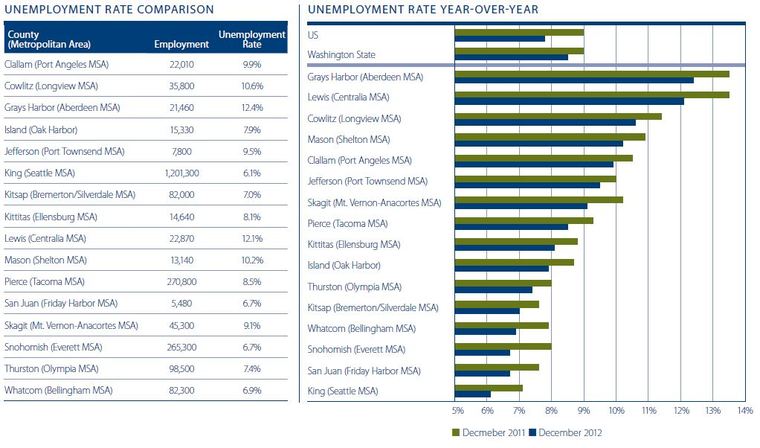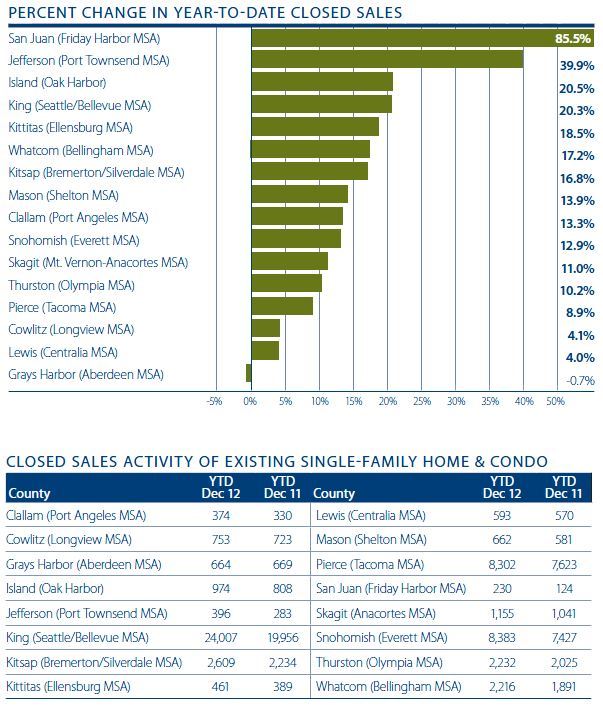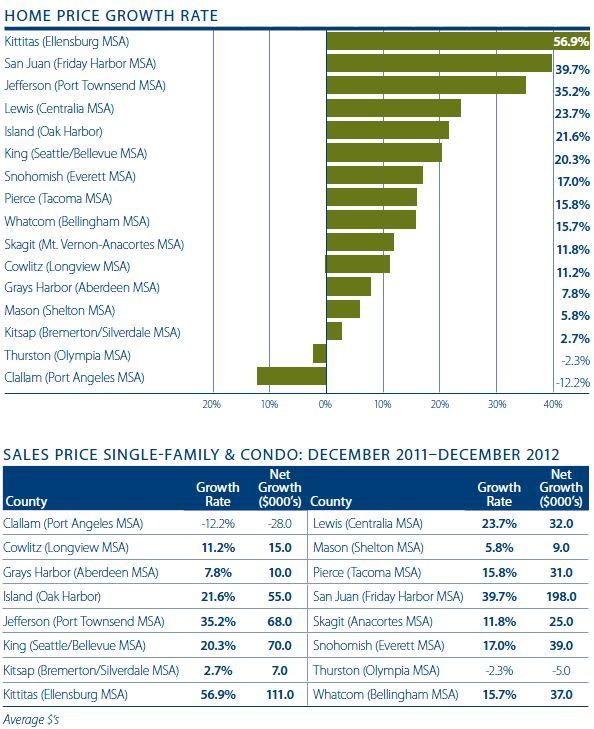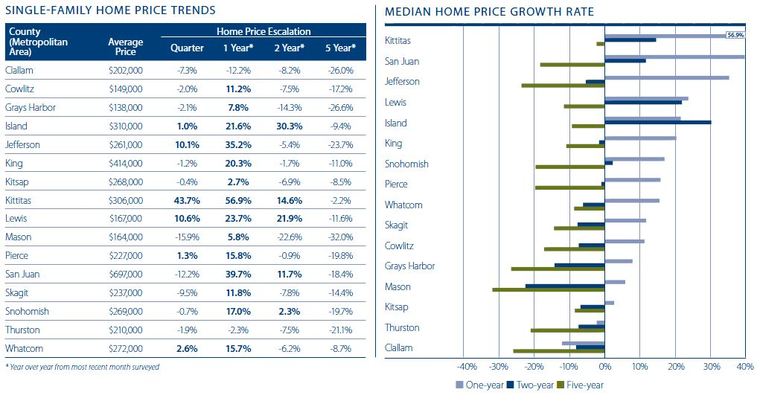Windermere Real Estate is proud to partner with Gardner Economics on this analysis of the Western Washington real estate market. This report is designed to offer insight into the realities of the housing market. Numbers alone do not always give an accurate picture of local economic conditions; therefore our goal is to provide an explanation of what the statistics mean and how they impact the Western Washington housing economy. We hope that this information may assist you with making an informed real estate decision. For further information about the real estate market in your area, please contact your Windermere agent.
Regional economics
One of the best-known lines in George Orwell’s famous book Animal Farm was the statement that, “All animals are equal, but some animals are more equal than others.” The same can pretty much be said about the counties contained within this report when it comes to economic growth.
With the exception of just three counties, all of the areas considered within this report showed job growth in 2012. In aggregate, the 16 counties added a total of 45,420 new jobs, measuring at a healthy 2.1%.
On an annual basis, the figures look quite good. The drop in employment that was seen between the second and third quarters has since turned around, with the market adding 5,290 new jobs.
However, when looking closely at the data, it is clear there are some counties that are experiencing a majority of the job growth and others that, although still expanding, are not faring as well as I would have hoped.
Year-over-year, San Juan County (+14.2%) grew at the greatest rate—it is a small county but its service industry appears to be reviving quite nicely. This was followed by Skagit (3.9%), Snohomish (+3.3%), Mason (+2.7%), and King (+2.4%) Counties. Job losses were modest, and included Kitsap (-1.1%), Jefferson (-0.3%), and Kittitas (-0.2%) Counties. Total employment in these three counties contracted by just 950 jobs.
Unsurprisingly, the majority of jobs gained in the market occurred in the central Puget Sound region that encompasses King, Snohomish, and Pierce Counties. Between them, they accounted for 89% of total job gains.
When we look at the unemployment rate across the region, all the counties reviewed saw rates drop from a year ago. Several counties did see their unemployment rates rise between the third and fourth quarters, but this was mainly due to increases in the labor force and not a cause for concern.
The latest data is positive and a turnaround from the third quarter, when I suggested that employment growth appeared to be losing some steam. As a result, I am going to give the economy a “B+” grade—up from the “B” I gave it in the third quarter.
Inasmuch as the economy appears to be on a stable footing, there are still headwinds. Many, including myself, had hoped that the confirmation of a new president would be enough to stimulate the economy and signal a faster expansion in jobs. Unfortunately however, fiscal cliffs, debt ceilings, and sequesters continue to act as anchors on our economic potential. I remain hopeful that we will get through these issues, but until we do, our economic vitality may well be muted.

Regional real estate
The market registered 40,270 transactions of resale housing units in 2012— an impressive increase of 15.7% over the number of transactions seen in 2011. In the fourth quarter, there were close to 13,740 transactions completed, which is also a very impressive figure.
With a clear level of optimism in the market, all but one county exhibited improved home sales in 2012 when compared to the previous year.
The solitary county where there were fewer sales recorded, Grays Harbor, remains an anomaly; the area is small and the decline in sales was measured at just five units.
Of the fifteen counties that saw higher sales, a full 80% reported doubledigit improvements in transactional volumes in 2012 when compared to 2011. The greatest increases were seen in the notoriously volatile San Juan County, where the market sold 106 more units in 2012 than in the prior year.
The area did see a slowdown in sales in the fourth quarter, but that is not surprising as we always see a seasonal slowdown at this time of year. That said, a contraction of just 11% in total sales between the third and fourth quarters is not bad at all.
Regular readers will be aware that through 2012 I have been waiting for an increase in the number of homes for sale. Unfortunately, my wishes have not been granted. There have also been many who have been waiting for a veritable tidal wave of foreclosed homes to flood the market and that, too, has not occurred.
I believe that we will see more bank-owned units come to market in 2013, but not at a level that is likely to negatively impact home prices in our area. In fact, I welcome any additions to the available stock as it is clear to me that there are more buyers than sellers in our region.

As is shown in the chart, 14 counties saw the average sales prices at levels above that seen a year ago—up one from my last report. In aggregate, the average price of homes sold in the counties analyzed was 19% higher at the end of 2012 than in December of 2011. I should note that the area saw home values reduce by 1.4% between the end of the September and the end of the year, likely due to seasonality as well as the lack of inventory in the marketplace.
Of the counties that saw appreciation, the most pronounced gains were seen in Kittitas (+56.9%), San Juan (+39.7%), Jefferson (+35.2), and Lewis (+23.7%). I am not surprised by this, as they are all markets that are fairly modest in size and, therefore, subject to some wild fluctuations. The declines that were seen were limited to Clallam (12.2%) and Thurston (-2.3%) Counties. The fairly substantial drop in values in Clallam County was again a function of small market size.
I continue to be pleased to see that several counties are now exhibiting sales prices that are above those seen two years ago. As was discussed in my last report, this is important, as the early summer of 2010 represented the end of the First Time Homebuyer Tax Credit that functioned to artificially (but temporarily) increase home prices. While we’re not close to seeing the prices that were achieved during the peak of the market five years ago, it is clear to me that the trend is clearly upward and I anticipate this to continue as we enter 2013.
As stated previously, I do worry about the lack of homes for sale. If we do not see a fairly dramatic increase in inventory, I fear that the market will be forced to give some of its recent gains back— albeit temporarily. Because of this fact, and regardless of the solid price growth that we are witnessing, I am still unable to raise my grade above the “C” that I gave it last quarter.


Conclusions
I remain in somewhat befuddled awe when I think of the resiliency of the United States economy and how we, as a nation, are emerging from this recession bruised but, for the better part, intact. Inasmuch as the government has tried, hopefully unwittingly, to hinder our growth with various budgetary issues and the like, we are doing our best to adapt to our environment and grow the economy.
I started out this piece with a quote from George Orwell which inferred that our job recovery, although occurring across the geographic board, will be unequal. I certainly expect that the power centers that accommodate a majority of our businesses in the state will expand at a faster rate than counties that are more removed. That said, the overall picture is a positive one and I expect that 2013 will be another year in which our regional economy outperforms the nation as a whole.
From a real estate standpoint, it is clear that we are now well removed from the days when home prices were hemorrhaging. Home values have stabilized and a recovery in values is underway. The credit markets have thawed and getting a mortgage is easier now than it has been since the housing “bubble” exploded. Interest rates remain at historic lows, and although I believe that they will rise in 2013, the increase should be modest.
The outlook is getting clearer. Home values will appreciate in 2013, but not all markets are created equal and some will fare better than others.
 About Matthew Gardner
About Matthew Gardner
Mr. Gardner is a land use economist and principal with Gardner Economics and is considered by many to be one of the foremost real estate analysts in the Pacific Northwest.
In addition to managing his consulting practice, Mr. Gardner is a member of the Pacific Real Estate Institute; chairs the Board of Trustees for the Washington State Center for Real Estate Research; the Urban Land Institutes Technical Assistance Panel; and represents the Master Builders Association as an in-house economist.
He has appeared on CNN, NBC and NPR news services to discuss real estate issues, and is regularly cited in the Wall Street Journal and all local media.
 Facebook
Facebook
 X
X
 Pinterest
Pinterest
 Copy Link
Copy Link



